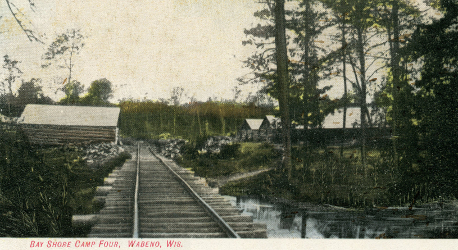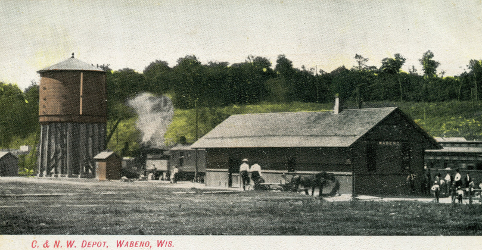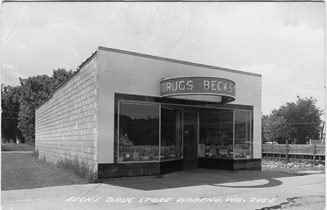
Overview of Wabeno circa 1905
A Brief History of Wabeno, Wisconsin
On June 2, 1880, a tornado swept across northern Wisconsin from Antigo to
Lake Superior, causing timber to blow down in a strip that measured ½ to
1 mile wide. The Native Americans called this area "Waubeno". "Waubeno" means "the
coming of the winds" or "the opening." The town took its name
from this event.

Overview of Wabeno circa 1905
Wabeno was officially established in 1897, though settlers had arrived earlier
for the rich timber resources. The early history of Wabeno centered around
the development of three lumber companies-the Menominee Bay Shore Lumber Company,
A.E. Rusch Company, and the Jones Lumber Company.
 |
 |
 |
In the late 1897 the Chicago and Northwestern Railroad pushed into the area creating a line between Wabeno and Green Bay. Sawmills were soon built along the tracks and towns grew up around the mills. The Wabeno Railroad Station in the 1910 picture at left provided commercial services for the logging industry as well as passenger service for the surrounding area.
|
 |
 |
 The
Forest County Potawatomi Community, also known as the Keeper of the Fire, settled
in Forest County around the same time as the logging industry was developing.
Homesteads were started under the Indian Homestead Act of 1894. Families settled
in areas near Blackwell and Wabeno as well as Crandon and Stone Lake. This
1906 photo shows a family in front of the railroad station’s land office,
now the Wabeno Public Library.
The
Forest County Potawatomi Community, also known as the Keeper of the Fire, settled
in Forest County around the same time as the logging industry was developing.
Homesteads were started under the Indian Homestead Act of 1894. Families settled
in areas near Blackwell and Wabeno as well as Crandon and Stone Lake. This
1906 photo shows a family in front of the railroad station’s land office,
now the Wabeno Public Library.
In 1905 there were five sawmills -the Bay Shore, Rusch, Jones, Prebe and
Mayflower. Together they produced 35 million
feet of lumber a year. The best laborers earned $1.25 per day  –not including
board. The Menominee Bay Shore Co was originally operating in Menominee MI
but as timber became scare in that area, the company president, Alex Soper,
moved the operation to just south of Wabeno in 1904. A village sprung up around
the Big Red Mill, as it was called, and a decision was made to call the village
Soperton.
–not including
board. The Menominee Bay Shore Co was originally operating in Menominee MI
but as timber became scare in that area, the company president, Alex Soper,
moved the operation to just south of Wabeno in 1904. A village sprung up around
the Big Red Mill, as it was called, and a decision was made to call the village
Soperton.
 The
Noer Hospital was built in the early 1900’s by Dr. Peter Noer. The
Ovitz Hospital in Laona was a larger medical facility and over time the Noer hospital
became more like a clinic. After Dr Noer retired, Dr. Tenley’s medical
practice movedto the former hospital and he remained there till his retirement
in the early 1960’s. The town honored Doc Tenley with a parade and community
luncheon at his retirement.
The
Noer Hospital was built in the early 1900’s by Dr. Peter Noer. The
Ovitz Hospital in Laona was a larger medical facility and over time the Noer hospital
became more like a clinic. After Dr Noer retired, Dr. Tenley’s medical
practice movedto the former hospital and he remained there till his retirement
in the early 1960’s. The town honored Doc Tenley with a parade and community
luncheon at his retirement.

The Grand Plank Hotel was a main stay establishment in Wabeno as a bar, hotel,
restaurant and dance hall.
Public schools were built to serve Wabeno and surrounding towns of Padus, Blackwell, Carter,Townsend and Lakewood. The first school built in 1897 was a one room school house, which has been refurbished and moved next to the Wabeno Public Library as a historical reminder of Wabeno’s earlier years.
|
|
|
 In
1920, two 4 room schools were built to accommodate the elementary grades. The
Washington school was on the main street in downtown Wabeno and taught the
town children. The Lincoln School, on the right, was in Soperton
and served rural families.
In
1920, two 4 room schools were built to accommodate the elementary grades. The
Washington school was on the main street in downtown Wabeno and taught the
town children. The Lincoln School, on the right, was in Soperton
and served rural families.
The Wabeno Town Hall was the site of town governance, the courthouse, jail and fire department for the community and even the library at one point. The original Town Hall was built in 1916 and replaced in 1985 in the same location.
 |
 |
The Wabeno Drug Store at left provided needed medical and pharmaceutical supplies and the Alburcan Dry Goods store on the right kept residents in clothes and household products.


All but the Menominee Bay Shore mill shut down between 1920 and 1930. In 1936, it too, was forced to close its doors. The cutover and burned lands were sold to prospective farmers but farming never developed to the extent envisioned due to the short northern growing season.
Despite the closing of the saw mills, Wabeno saw business and tourism growth
through the 1940’s and 1960’s and was a vibrant hub in Forest County.
|
| |
 1940's |
 1960's |
Numerous businesses flourished; Cheney Motor Company, the Red Owl, the Wabeno Theater, Happy’s Shoe Store, Rusch’s Grocery and Meat Market, Sparks’s Grocery, Schalfke Bakery, a bowling alley and roller skating rink, a wooden boat and stool factory, a barbershop, shoe repair store, the State Bank of Wabeno, Wabeno Apparel, Twin City Lumber, the Ben Franklin Store, Beck's Drug Store, International Harvestor, Coast to Coast Hardware, an A & W Root Beer Stand, Sinclair Gas station and Standard Oil plus several restuarants and 13 taverns!
 |
 |
|
 |
 | |
 |
 |
|
Sources:
Compiled March 5, 2013